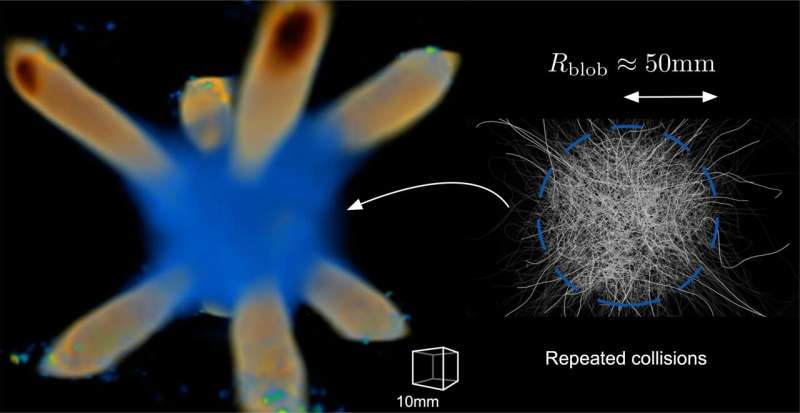June 20, 2023 feature
This article has been reviewed according to Science X's editorial process and policies. Editors have highlighted the following attributes while ensuring the content's credibility:
fact-checked
peer-reviewed publication
trusted source
proofread
A new approach to controlling the properties of turbulence

Turbulence, a fluid motion characterized by chaotic changes in flow velocity and pressure, has been the topic of countless physics studies. Although turbulence is a very common phenomenon that occurs in nature, manipulating it and controlling its properties had so far proved incredibly challenging.
Researchers at University of Chicago recently introduced a new strategy to reliably control the location, position and properties of turbulence in experimental settings. This strategy, introduced in a paper published in Nature Physics, allowed them to create an isolated turbulent blob within a calm environment.
"Turbulence can be found everywhere. Stirring coffee with a spoon is a good example," Takumi Matsuzawa (first author on the study) and William Irvine (corresponding author on the study), told Phys.org. "Nevertheless, manipulating this ephemeral phase of matter is not as easy as the other conventional phase of matter such as solid and liquid. In many cases, the material boundaries, like the spoon in the previous example, obscure what the turbulence has been fed. This led us to question whether it is possible to create an isolated blob of turbulence and hold it in place."
As part of their recent study, Irvine and his colleagues set out to create a confined state of turbulence within a quiescent environment, which would require the precise control of the properties of turbulence. The successful creation of such an isolated blob could open interesting new avenues for research, allowing physicists to explore questions that have been difficult to answer using traditional experimental methods.
"Some of the questions that could be explored following our study include: what happens at the interface of turbulent and non-turbulent flows? How are conserved quantities such as energy and impulse transported across the interface? Are there different types of turbulence depending on the combinations of conserved quantities?" Irvine and Matsuzawa said.
Many physics textbooks and theoretical works describe turbulence as a soup of swirling motions known as "eddies." While the unique characteristics of eddies remain rather elusive, they are essentially movements in a fluid that deviate from its general flow, such as circular currents or vortices.
"Our proposed approach entails building turbulence by placing eddies one at a time, like Legos," Irvine explained. "Nobody truly knows what an eddy is, but a vortex ring, aka a smoke ring, is a good candidate, as it is a robust fluid structure and can travel far from the material boundaries. Moreover, its properties can be fully measured so we know what we feed into turbulence."
In their experiments, Matsuzawa combined sets of eight vortex rings in a chamber, by firing them toward the center of a cubic water-filled tank from the eight corners. If these vortex rings were to be fired as a single set, they would divide and redirect, due to an effect known as vortex reconnections. Firing them repeatedly, however, as executed by the researchers, leads to the formation of an isolated blob of turbulence.
"Our approach provides unique design principles to localize, position, and control turbulence," Irvine said. "The properties of the blob are set by those of vortex rings; the size is set by the ring radius; the inner turbulent intensity is set by the energy carried by the rings. If we combine helical loops, we could also inject the other conserved quantities such as angular impulse and helicity, whose roles in turbulence are not well-known."
The recent work by this team of researchers greatly contributes to the study of turbulence, introducing a promising strategy to reliably control it experimentally. In the future, the strategy introduced in their paper could pave the way for new studies that would have previously been difficult to carry out. This could in turn help to answer long-standing research questions relating to the physical processes underpinning turbulence.
"We are currently investigating how turbulence freely evolves in a quiescent environment," Irvine added. "This is an important question regarding how turbulent fluctuations spread and die out. We are also interested in studying how turbulence 'forgets' what has been fed. It is believed that turbulence is universal in the small scales even if the vortical structures in the input are different. Our system would be ideal to study this memory in turbulence by tuning the input by combining various vortex loops."
More information: Takumi Matsuzawa et al, Creation of an isolated turbulent blob fed by vortex rings, Nature Physics (2023). DOI: 10.1038/s41567-023-02052-0
Journal information: Nature Physics
© 2023 Science X Network





















